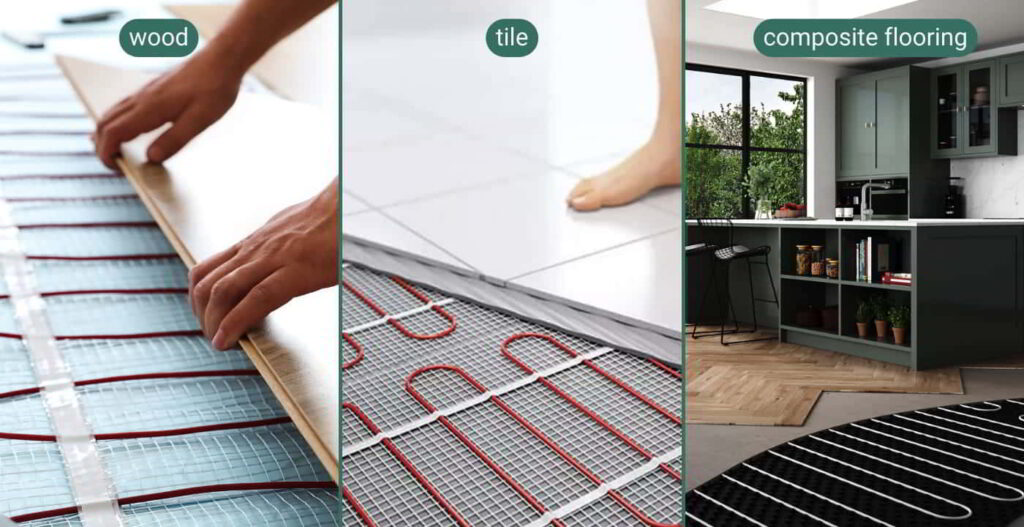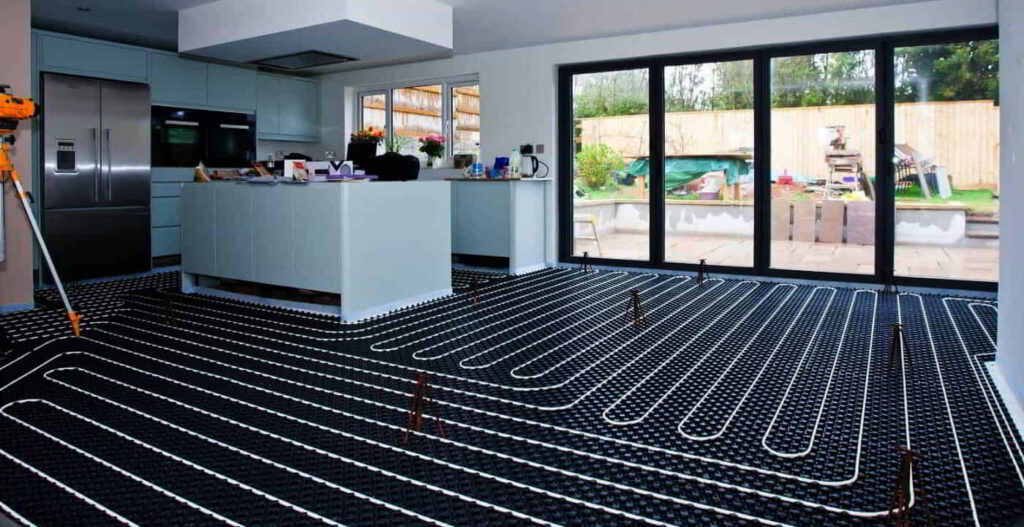- Sign-In
- Sign-Up
The cost of a heated kitchen floor will comprise several different expenses.
Luckily, the cost isn’t as high as many assume. To begin with, the underfloor heating system itself will typically cost around $14 per square foot.
The flooring material is the next factor, with some materials like vinyl costing as little as $2 per square foot.
This price will be higher if you opt for more expensive materials like Marble.
The cost of installation will also vary depending on the type of flooring and the complexity of the layout. However, the usual price range for installation is somewhere between $8–$20 per square foot.
That’s basically it unless your project requires you to replace the existing subfloor ($3–$10 per square foot) and add new underlay ($0.50-$4.50 per square foot).
With all these different factors considered you can normally expect to pay somewhere around $24-$70 per square foot for a fully installed heated kitchen floor.
For an average-sized kitchen in America (approx. 170 square feet) the usual cost range will sit between $4,080 and $11,900 with the higher prices accounted for by using luxury, high-end flooring materials like Marble.
For most people, the primary reason for choosing heated kitchen floors is to increase their comfort in the busiest room in their house.
Typically, kitchens have hard, cold flooring materials, such as tile or wood, and heated floors add warmth and comfort to the room. However, this innovative heating solution offers more than just a unique way to keep your toes feeling toasty.
These are a few of the additional benefits that you will enjoy when you invest in radiant floor heating for your kitchen:
It also can be used as a primary heat source, minimizing your reliance on a traditional heat source, such as a furnace or radiator.
The cost of operating underfloor heating is much less than running a furnace to heat your entire home.
Heated floors are an invaluable investment you can make in your kitchen. Not only will underfloor heating allow you to enjoy a higher quality of life in your own home, but prospective buyers will be impressed with your heated floors if you ever decide to list your home on the market.
Ultimately, you will likely enjoy a significant return on the investment you made when renovating your kitchen. Either through savings made on electricity bills, or increased value to your home, maybe even both.

Once you have added underfloor heating to your kitchen renovation project, the next step is determining which flooring materials will work best for your space.
Fortunately, you have a lot of flexibility when choosing flooring materials for your heated kitchen floors, and you will not have to compromise on style, color, or price.
These are the best materials to consider for your heated kitchen floors:
Natural flooring materials like wood are often the perfect choice for heated kitchen floors.
Wood floors will complement the style and design of your renovated kitchen, heat up quickly, and retain the heat.
Remember that some natural woods are affected by humidity and can warp if exposed to too much moisture.
For the most part, this isn’t an issue in kitchens, but it may be something to consider depending on the location and size of your home.
| Project Expense | Cost |
|---|---|
| Hardwood | $6-22/ft² |
| Or | |
| Engineered Wood | $4-16/ft² |
| Plus | |
| System Cost | $14/ft² |
| Plus | |
| Installation Cost | $8-20/ft² |
| Plus | |
| Subflooring Replacement Costs | $3-10/ft² |
| Plus | |
| Underlayment Costs | $0.50-4.50/ft² |
| Total | |
| Low-End Estimate | $29.50/ft² |
| to | |
| Upper-End Estimate | $70.50/ft² |
Tile and stone are also attractive choices when considering underfloor heating in your kitchen.
With so many styles and color combinations, tile is often a preferred design option — but it also has the highest thermal conductivity rating.
Both of these flooring materials will heat up quickly and retain the heat for a long time, and beyond that, the heat makes these floors much more comfortable to step on.
| Project Expense | Cost |
|---|---|
| Tiles or Stone Flooring | $6-20/ft² |
| Plus | |
| System Cost | $14/ft² |
| Plus | |
| Installation Cost | $8-20/ft² |
| Plus | |
| Subflooring Replacement Costs | $3-10/ft² |
| Plus | |
| Underlayment Costs | $0.50-4.50/ft² |
| Total | |
| Low-End Estimate | $31.50/ft² |
| to | |
| Upper-End Estimate | $68.50/ft² |
Laminate flooring can be viable for heated floors, but you want to involve your radiant floor contractor.
Some hybrid flooring options may have a maximum surface temperature. You will want to verify that these floors will work well with the underfloor heating system you are considering.
Working closely with your heated floor contractor when deciding on your flooring materials is essential. Your contractor can help you determine the best flooring types for your particular kitchen.
| Project Expense | Cost |
|---|---|
| Laminate or Vinyl Plank | $2-7/ft² |
| Or | |
| Luxury Vinyl Plank | $7-10/ft² |
| Plus | |
| System Cost | $14/ft² |
| Plus | |
| Installation Cost | $8-20/ft² |
| Plus | |
| Subflooring Replacement Costs | $3-10/ft² |
| Plus | |
| Underlayment Costs | $0.50-4.50/ft² |
| Total | |
| Low-End Estimate | $27.50/ft² |
| to | |
| Upper-End Estimate | $58.50/ft² |
Concrete floors, celebrated for their robustness and stylish appearance, are gaining popularity in contemporary interior design.
Beyond the aesthetic appeal, they are also excellent for heat retention with underfloor heating systems due to their high thermal mass.
| Project Expense | Cost |
|---|---|
| Concrete Flooring | $2-8/ft² |
| Plus | |
| System Cost | $14/ft² |
| Plus | |
| Installation Cost | $8-20/ft² |
| Plus | |
| Subflooring Replacement Costs | $3-10/ft² |
| Plus | |
| Underlayment Costs | $0.50-4.50/ft² |
| Total | |
| Low-End Estimate | $27.50/ft² |
| to | |
| Upper-End Estimate | $56.50/ft² |
Marble floors offer unmatched elegance and timeless beauty, making them an exceptional choice for heated kitchen floors.
Beyond their luxurious appearance, marble floors heat up efficiently and distribute warmth evenly, adding a touch of comfort to their aesthetic appeal.
However, it’s important to note that marble can be sensitive to acidic substances and may require more maintenance to preserve its polished look.
Despite this, its durability and the sophisticated atmosphere it lends to any kitchen renovation make it a worthwhile consideration, especially for those looking to elevate the style of their home.
| Project Expense | Cost |
|---|---|
| Marble Tiles | $5-10/ft² |
| Or | |
| Marble Slabs | $10-20/ft² |
| Plus | |
| System Cost | $14/ft² |
| Plus | |
| Installation Cost | $8-20/ft² |
| Plus | |
| Subflooring Replacement Costs | $3-10/ft² |
| Plus | |
| Underlayment Costs | $0.50-4.50/ft² |
| Total | |
| Low-End Estimate | $30.50/ft² |
| to | |
| Upper-End Estimate | $68.50/ft² |
A widespread myth about radiant floor heating is the belief that it’s exclusively compatible with wood or stone floors.
However, installing radiant floor heating beneath carpeting is not just feasible—it’s actually favored by many homeowners.
A carpet with electric heating underneath becomes warm, welcoming, and exceptionally comfortable, offering additional warmth to the space.
Radiant heating under carpets is often used as the main heating source, especially in rooms built over concrete slabs.
| Project Expense | Cost |
|---|---|
| Concrete Flooring | $7.9-15/ft² |
| Plus | |
| System Cost | $14/ft² |
| Plus | |
| Installation Cost | $8-20/ft² |
| Plus | |
| Subflooring Replacement Costs | $3-10/ft² |
| Plus | |
| Underlayment Costs | $0.50-4.50/ft² |
| Total | |
| Low-End Estimate | $23.40/ft² |
| to | |
| Upper-End Estimate | $63.50/ft² |

While it is possible for radiant floor heating to be retrofitted to your existing floors, the best time to install this solution is during renovation.
Radiant floor heating installation is surprisingly quick and easy, mainly when you work with an experienced and trusted contractor, such as Green Wave Distribution.
Here are a few things that you need to know about the installation process:
When you work with the right contractor, your heated floor installation will move smoothly and without issue.
A qualified contractor will install everything properly while respecting your space and ensuring no damage is done to your property.
Our innovative STEP Heat system is the best in its class, offering our clients an effective heating solution and an opportunity to live more sustainably.
Using automated carbon polymer heating technology, our STEP HEAT radiant flooring solution is safe, efficient, durable, and sustainable.
The STEP Heat system costs $14 per square foot, meaning you can have it installed in your kitchen at prices starting at less than $25 per square foot (depending on the flooring type).
Contact us today for more information about how Green Wave Distribution can help improve your kitchen renovation with underfloor heating solutions.
